Jürgen Klopp is leaving Liverpool Football Club at the end of the current campaign. That sentence has put smiles on the faces of fans of rival clubs but has also put a dagger through the hearts of Kopites around the globe. Whether you like Klopp or not, no matter where your loyalties lie in the game, there is simply no denying that what Klopp has achieved with the Reds is monumental. Frankly, we could sit here for hours and talk about how good his Liverpool sides have been at different points of his reign, the trophies he’s won, the players he’s transformed into world-class superstars, etc., but we already know all of that.
The question on everyone’s lips is simple–who will be Klopp’s successor? This is a huge moment in time for the club’s hierarchy; they really cannot afford to get it wrong. Certain sports news broadcasters have linked club legend Steven Gerrard with the soon-to-be vacant job, but that is a highly unlikely outcome for several reasons. The dream of having a club icon as the next manager may not be completely dead yet, though – Bayen Leverkusen manager Xabi Alonso has emerged as the overwhelming favourite early on, but time will tell if those odds can be trusted.
In this data analysis, we will aim to highlight three top candidates for the role, using statistics from the last three seasons of managers who, in one way, shape, or form, have shown tactical similarities to Klopp’s Liverpool. That’s the idea here – seeing which managers would come in and be something of a continuation of what Jürgen Klopp has built, not a complete restart. We will look at data that relates to three key tactical areas in this analysis – Liverpool’s off-the-ball aggression, their phenomenal attacking output in the final third, and their possession progression. We will then, of course, highlight which managers have stood out the most based on the data to draw a conclusion of which three managers should be up for consideration.
Criteria
In terms of criteria for selection, we followed a few simple rules to select the managers involved in this data analysis. Firstly, it is essential to note that we are only looking at coaches/managers who are currently employed in Europe’s top five leagues as listed by Wyscout (English Premier League, Spanish La Liga, Italian Serie A, French Ligue 1, and German Bundesliga). Of course, there is the chance Liverpool hire someone outside of this parameter, unlikely as it may be.
From there, we looked at the rankings among those leagues for metrics that have been important to Klopp over the years; metrics, of course, in which Liverpool have shown an ability, and highlighted clubs that showed similar abilities in certain areas this season, or since 2022/23 or 2021/22 (ranging from manager to manager, depending on their time within the top five leagues/when their club started to improve drastically). Below is a table that shows all managers (and their teams) involved in this analysis.
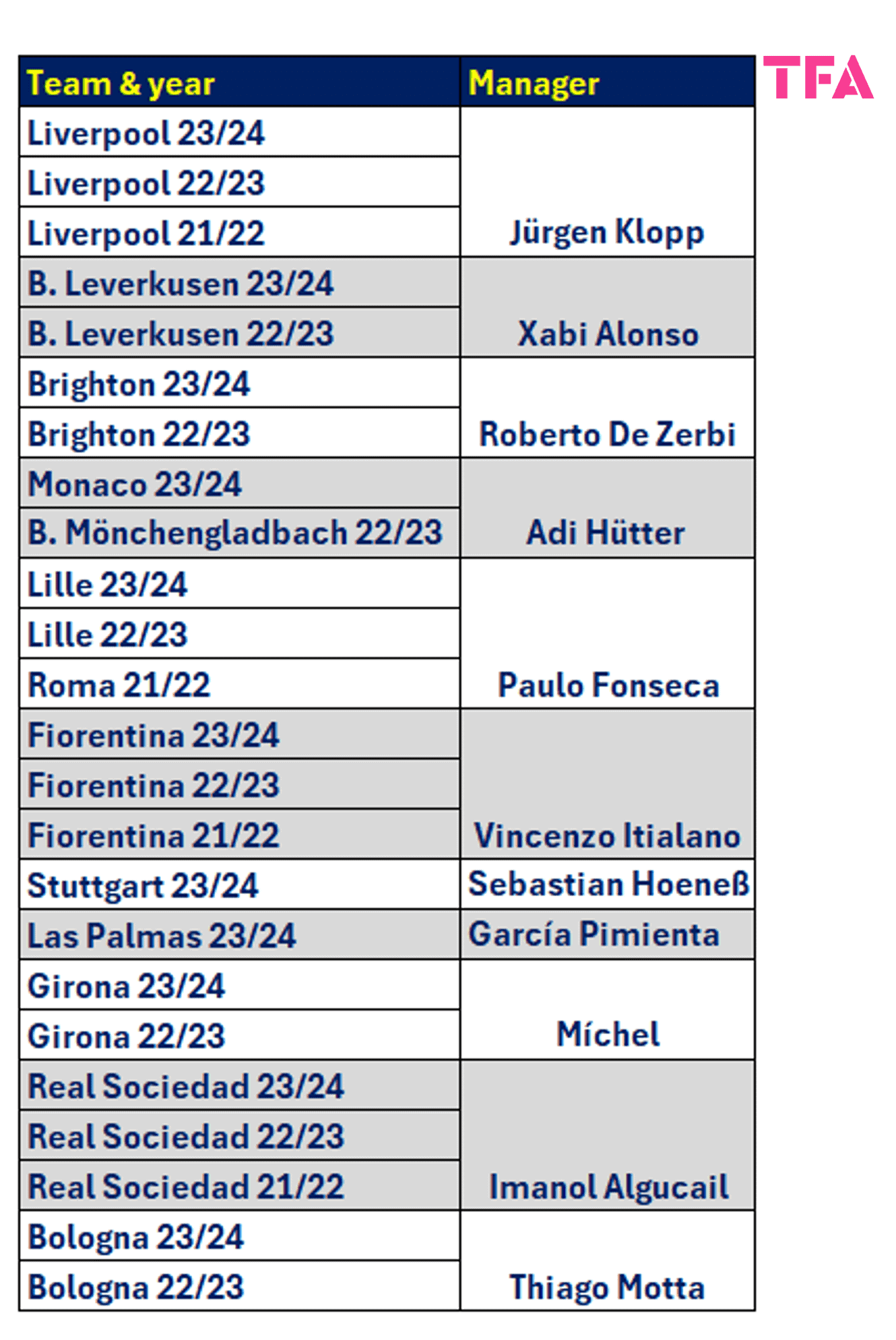
There may be some names you did not expect to see in relation to the Liverpool job, but again, we have selected managers based on their team’s apparent similarities to Klopp’s Liverpool tactics while also trying only to include realistic options from Europe’s top five leagues – they aren’t going to take Pep Guardiola from Manchester City, for example.
However, this is an excellent chance to highlight some high-profile managers who are currently unemployed but would not be out of place in the list of possible job contenders. The likes of Hansi Flick, Joachim Löw, and even Zinedine Zidane could all be interesting choices for the Reds – Zidane, in particular, has an excellent calibre at the top level of club football. Meanwhile, names like Antonio Conte, José Mourinho and Graham Potter are still without a job in football management. Still, they are far less likely to be brought in at Anfield for various reasons.
Out of possession
Liverpool are known for their high-intensity approach out of possession – a tactical trademark of Klopp’s which hark back to his Dortmund days. While there are teams out there who utilise similar aggression off-the-ball, it was Klopp’s ability to strike a fantastic tactical balance that has made his side unplayable much of the time. Here, we look at which managers deploy similar pressing tactics successfully – a critical tactical element to consider if Liverpool want that to continue in the post-Klopp era.
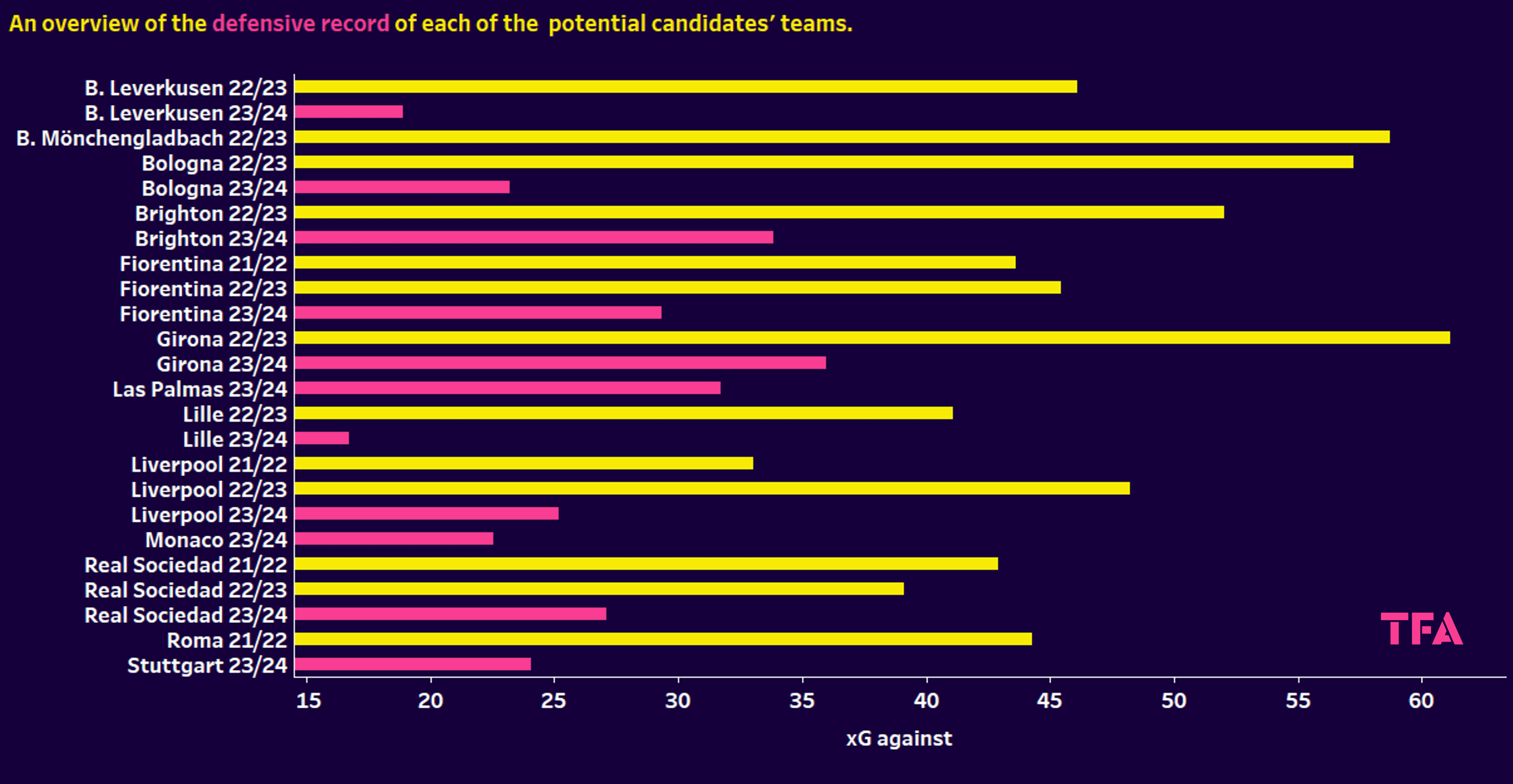
Yes, this segment is aimed at the pressing side of defending, and that graph will follow this one. But the general defensive record is an essential factor that must be considered. Since this season is ongoing, the overall xG-against for 23/24 teams will be lower than 22/23 & 21/22 teams – the teams from this season have been highlighted in pink, while the teams from previous campaigns have been highlighted in yellow.
Looking firstly at Liverpool’s defensive evolution. Last season was something of a poor one, from a Reds perspective, with the club finishing fifth – the campaign before (21/22), they took City to wire in the title race only to lose out by a single point. They have seemingly returned to form this season with a new-look lineup, and their defensive unit is more than pulling their weight. So far, they’ve conceded 18 goals in the EPL this season – the league’s best defensive record, from an xG against of 25.16 – Alisson has received a good number of plaudits this season.
There are a few clubs who better Liverpool’s xG against at the time of writing – Alonso’s Leverkusen, Adi Hütter’s Monaco, Paulo Fonseca’s Lille, Sebastian Hoeneß’s Stuttgart, and Thiago Motta’s Bologna have all recorded faced a lower xG in 23/24.
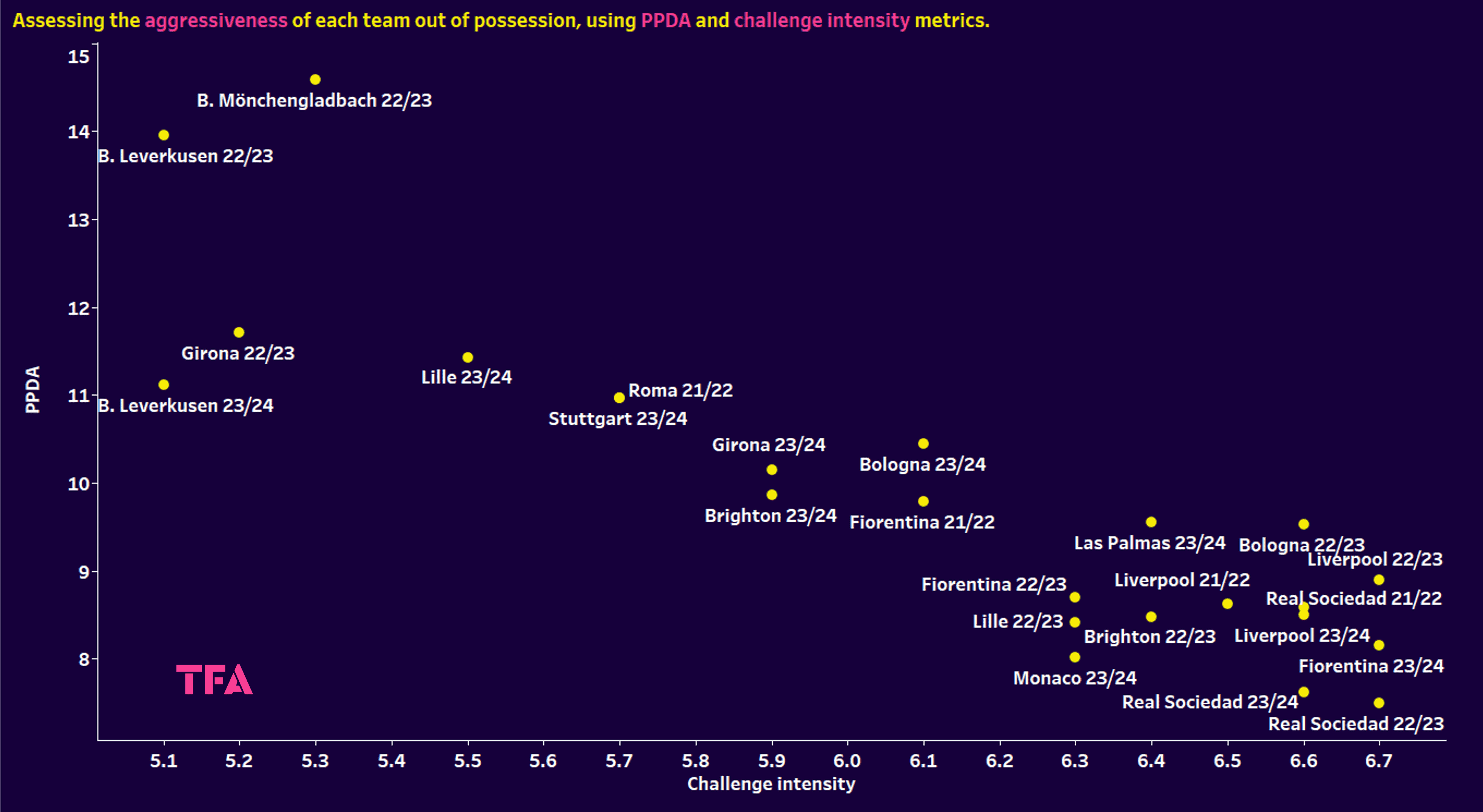
Onto the aggressiveness of the involved teams & managers. This graph considers two metrics that go a long way in painting a picture of how each team approaches things off the ball. Again, remember that every team/manager selected for this analysis was done so due to their tactical similarities to Klopp in isolated metrics. It’s also important to remember that a lower PPDA (passes per defensive action) score equates to a higher-intensity approach. Essentially, the teams in the bottom right of the above graph are amongst the most intense and aggressive teams in Europe’s top five leagues.
Impressively and unsurprisingly, Liverpool has remained in that bottom right quadrant for the last three seasons, indicating strong consistency in their high-intensity defence. This is where we also start to get a clear picture of which managers should perhaps be more respected than they are. Real Sociedad, currently managed by Imanol Algucail, have become a real force in Spain, with the 52-year-old deploying a high-intensity approach off the ball. Under his guidance, Sociedad have finished sixth or above every season since 2019/20 – his first entire season.
Roberto De Zerbi, who would be an ideal candidate to replace Klopp, especially if the board wants someone with EPL experience, used a high-intensity approach last season, according to the data, but that intensity has been lowered this season, likely in a bid to make his side more tactically balanced. Bologna fall under a similar category but remain a fairly aggressive side off the ball.
Fonsesca is an interesting one. At 50 years of age, he still has a long time left in his management career but already has an impressive CV. The current Lille boss has formerly managed the likes of Porto and Roma, and since his 21/22 season in Italy, he seems to be stepping up in terms of tactical success and flexibility. His Lille team last season were highly intense and aggressive but have significantly lowered that aspect of their game this season.
Interestingly, the current odds-on favourite Xabi Alonso shows signs of preferring a different approach to Klopp off-the-ball, opting to avoid the more aggressive tactics we’ve seen from the German over the years.
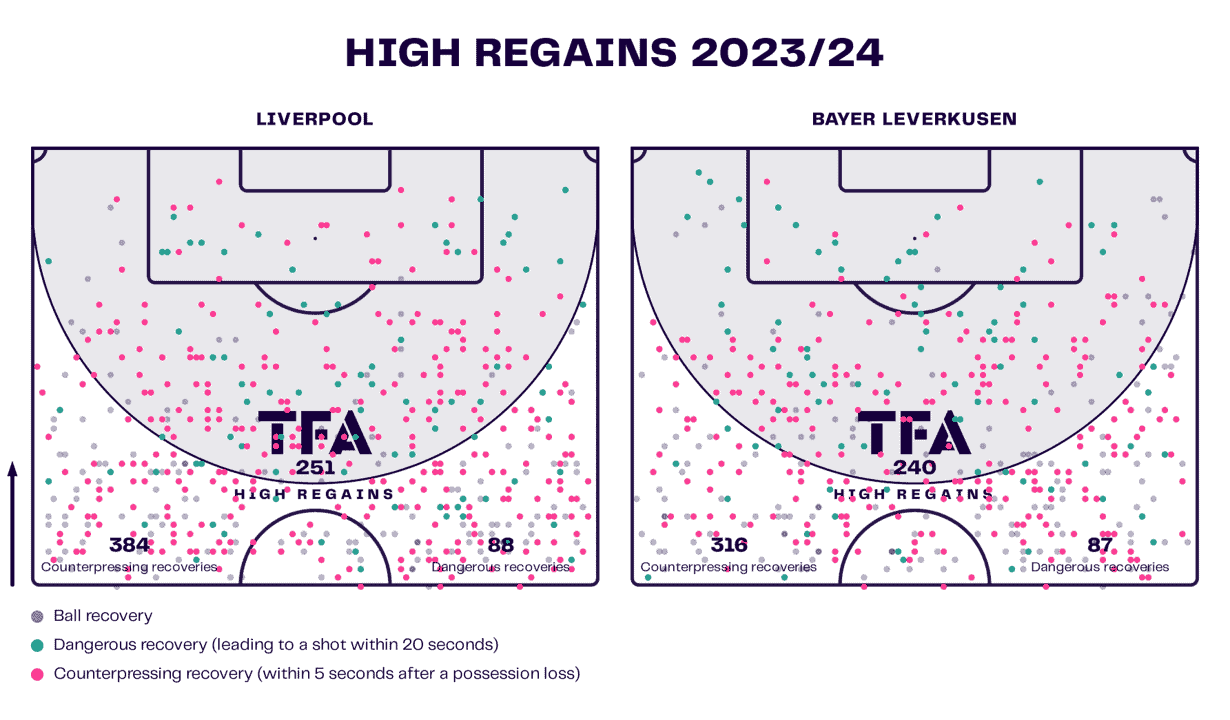
This visual gives us a clearer idea of how Klopp’s defensive approach differs from Alonso’s and in what areas. It is important to note that, this season, Alonso’s side have recorded a lower PPDA score than last season, suggesting an increase in aggression.
His Leverkusen side also post similar numbers in terms of high regains and dangerous recoveries, proving that they do operate in an aggressive manner to win the ball back. The difference maker is how they approach transitions – Klopp’s Liverpool are masters at counterpressing, which seems to be the main difference in approaches from a tactical view.
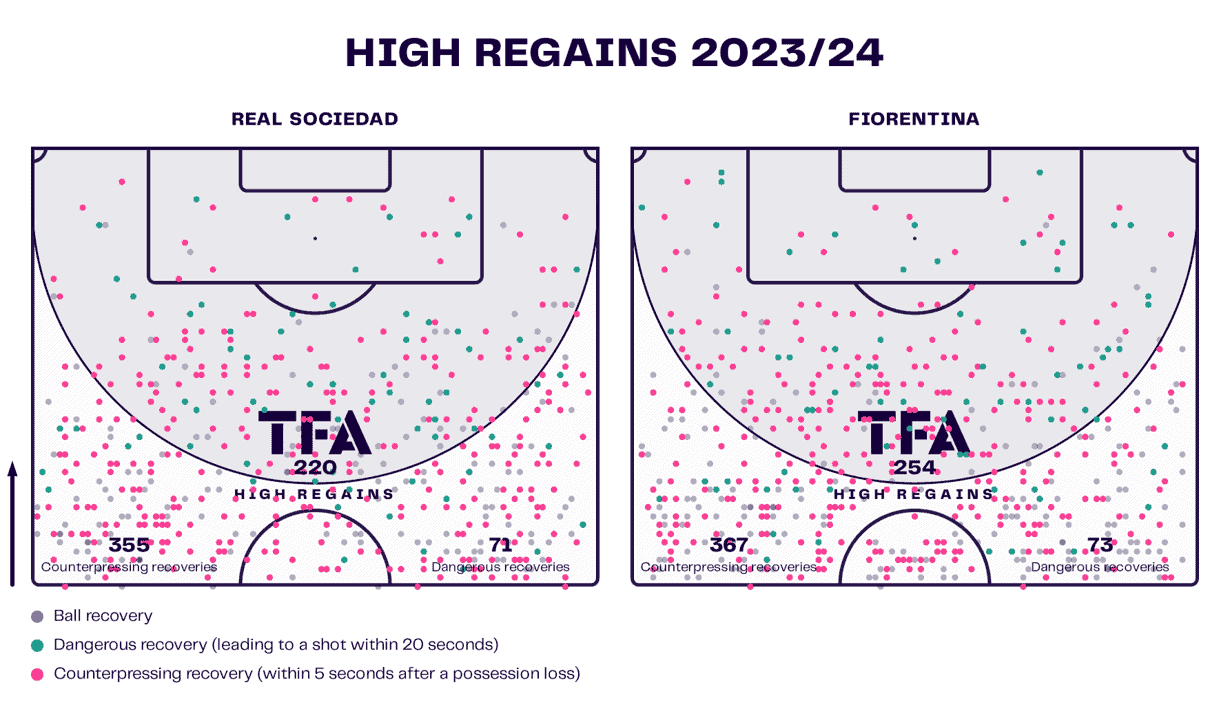
We touched on Real Sociedad’s impressive numbers out of possession – again showing a lower intensity in high regains and dangerous recoveries than both Liverpool and Leverkusen, but they also like to press the ball after losing it rather than regrouping.
One manager we haven’t yet mentioned is Fiorentina’s Vincenzo Italiano, who has led his side through an impressive tactical evolution since his arrival in 2021. He has also made Fiorentina regulars in terms of fighting for European spots in recent seasons, taking the club out of mid-table mediocrity. High pressing is an important part of his game, as his data above shows us.
Possession progression
Klopp has made his Reds effective in several areas of possession – from playing well in transitions to figuring out how to play against a low block successfully (the latter was often a problem for Liverpool in Klopp’s early days at Anfield). Liverpool are undoubtedly talented in moving possession forward – this segment of analysis looks at how the other coaches fair in that regard.
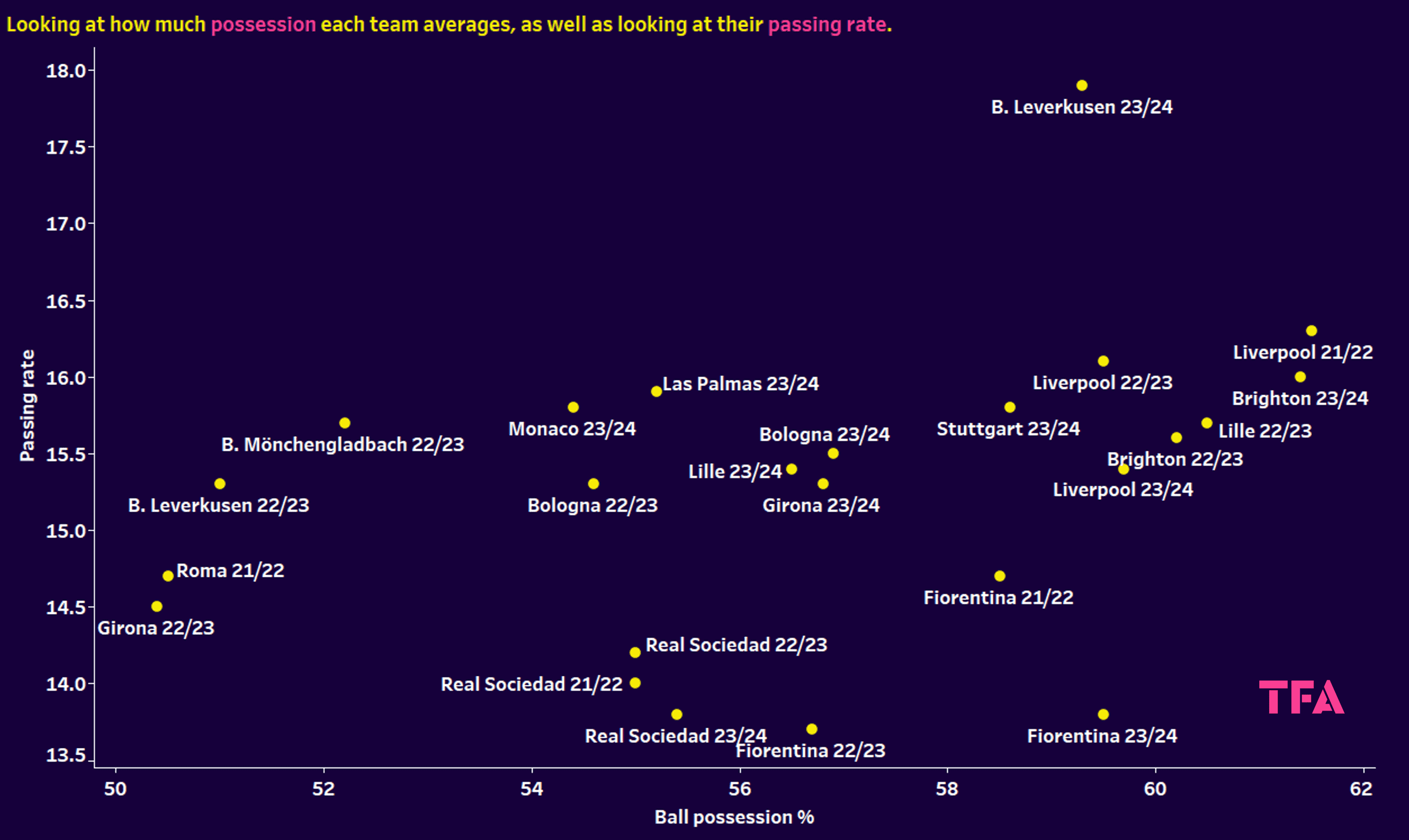
“Possession doesn’t win you games.” Yeah, we know! But, in certain tactical philosophies, it is an essential ingredient. Klopp’s Liverpool are known for their impact on the break, but, as the data shows, they are used to dominating large portions of possession, and have been for pretty much all of the German’s reign.
It’s that man Alonso again. His side have a high possession average this season but they also have an incredibly high passing rate of 17.9 (passes per minute of possession), indicating that they like to move the ball quickly with plenty of short passes involved in build-up play. They have the highest passing rate in Europe’s top five leagues at the time of writing. Brighton’s class of 23/24 pop up again, showing similar numbers to the Reds in terms of possession and passing rate, while Stuttgart and Lille shine well again.
An interesting one that highlights a different yet clearly effective approach is Fiorentina’s data. Under Italiano, they average high possession, especially this season, but usually register a low passing rate (in comparison to those in this analysis) – indicating either a slow tempo with short passes or a higher frequency of longer passes to progress possession. Either way, there is a clear tactical identity there that is working since the club are currently in fourth place in Serie A.
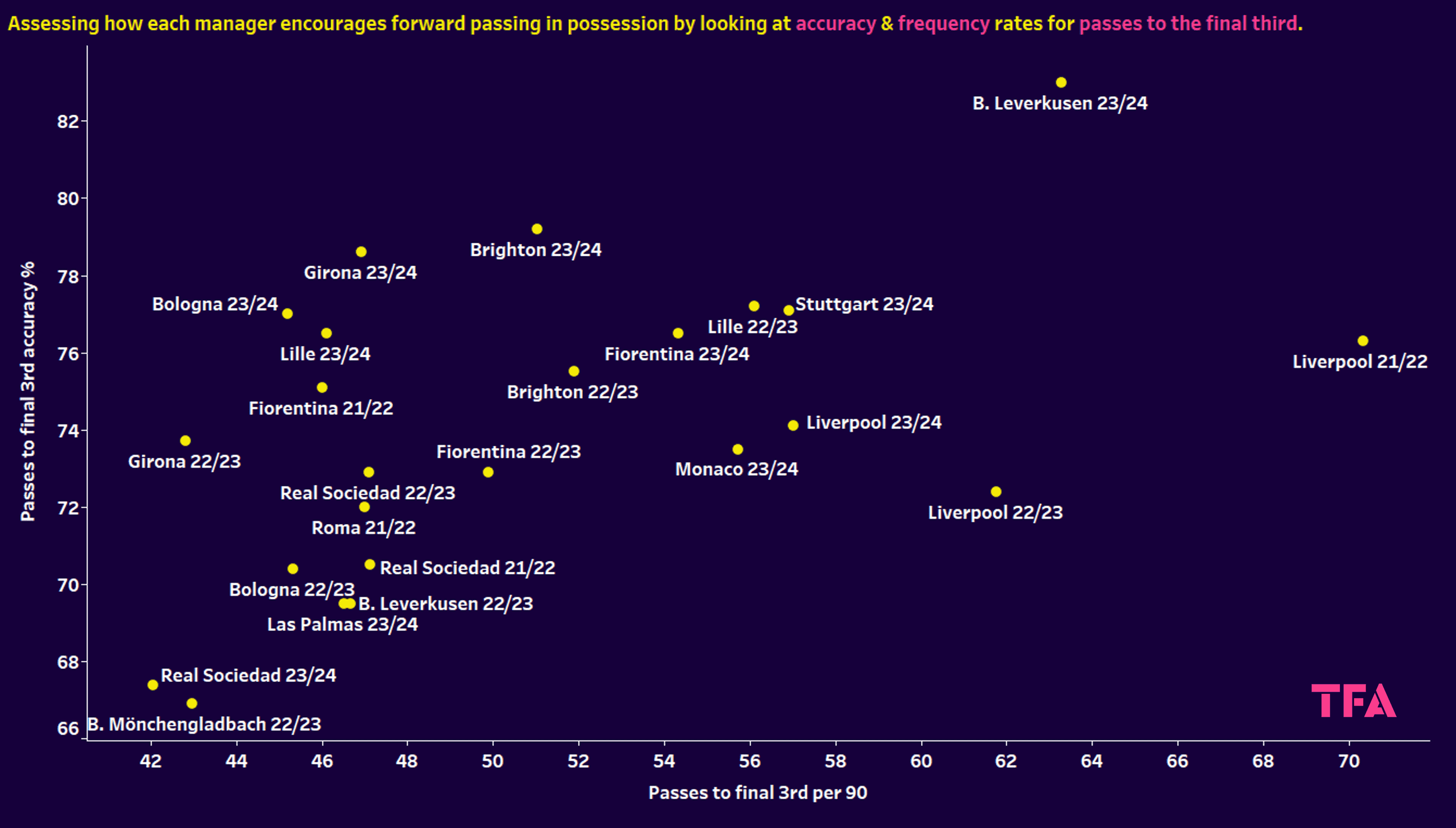
Speaking of progressing possession, we’ve opted to analyse each team’s frequency of passes to the final third – a high average number of attempts highlights a clear and consistent attacking attempt; a high accuracy simply indicates a talent in that area. Liverpool thrive at this, usually in wide areas, but they’re no strangers to exploiting central areas either.
Leverkusen are stood out on their own again. This time, it’s down to their high frequency of passes to the final third and their exceptionally high accuracy in this metric, highlighting tactical solidarity but also indicating a strong level of individual coaching from Alonso. Does that sound familiar?
If Hoeneß was a more high-profile name like Alonso, it’s highly likely that there would be a similar media frenzy about his chances of going to Anfield to what Alonso has received. Hoeneß is doing incredible things with Stuttgart – we’ve highlighted his side already in certain parts prior to this one, but his team’s ability to progress possession, proven by the graph above, is a credit to his pedigree as a coach. Fiorentina and Lille also share similar tendencies in this area of play.
Attacking output
Liverpool have had some simply iconic attacking lineups during the Klopp era. For years, they have blown the opposition away with their ability to create chances in a split second and attack with deadly intent. The consistency of this quality was also impressive, so which other managers have been able to get their team firing in a similar fashion?
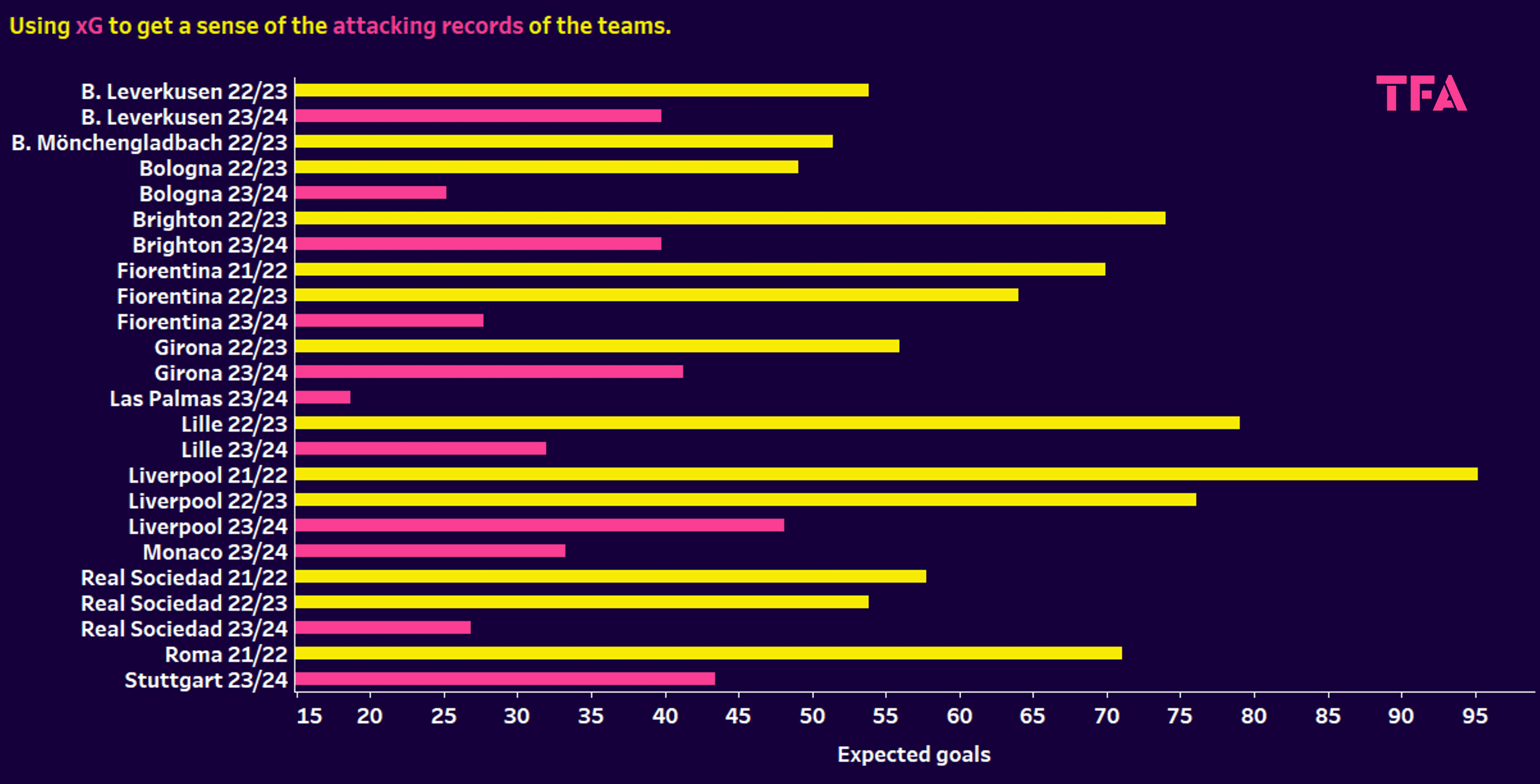
Here, we can see how each manager has faired in drawing the attacking cohesion and ability out of their respective squads. Whoever replaces Klopp will need to have a proven track record in terms of guiding a clinical attacking unit, with Liverpool being no strangers to blowing opponents away with high score lines.
This season, Liverpool’s xG of 48.08 is unmatched by the clubs involved – an endorsement of the work Klopp & co. have done: they’ve been simply phenomenal in attack. A couple of teams offer similar attacking consistency, though; the second-highest xG of the group for this season comes from Stuttgart, led by Sebastian Hoeneß, one of Europe’s top up-and-coming managers. While the numbers suggest that his approach off the ball is not as intense as Klopp’s his side’s work on the ball is anything but tame. Their xG of 43.45 this season proves that.
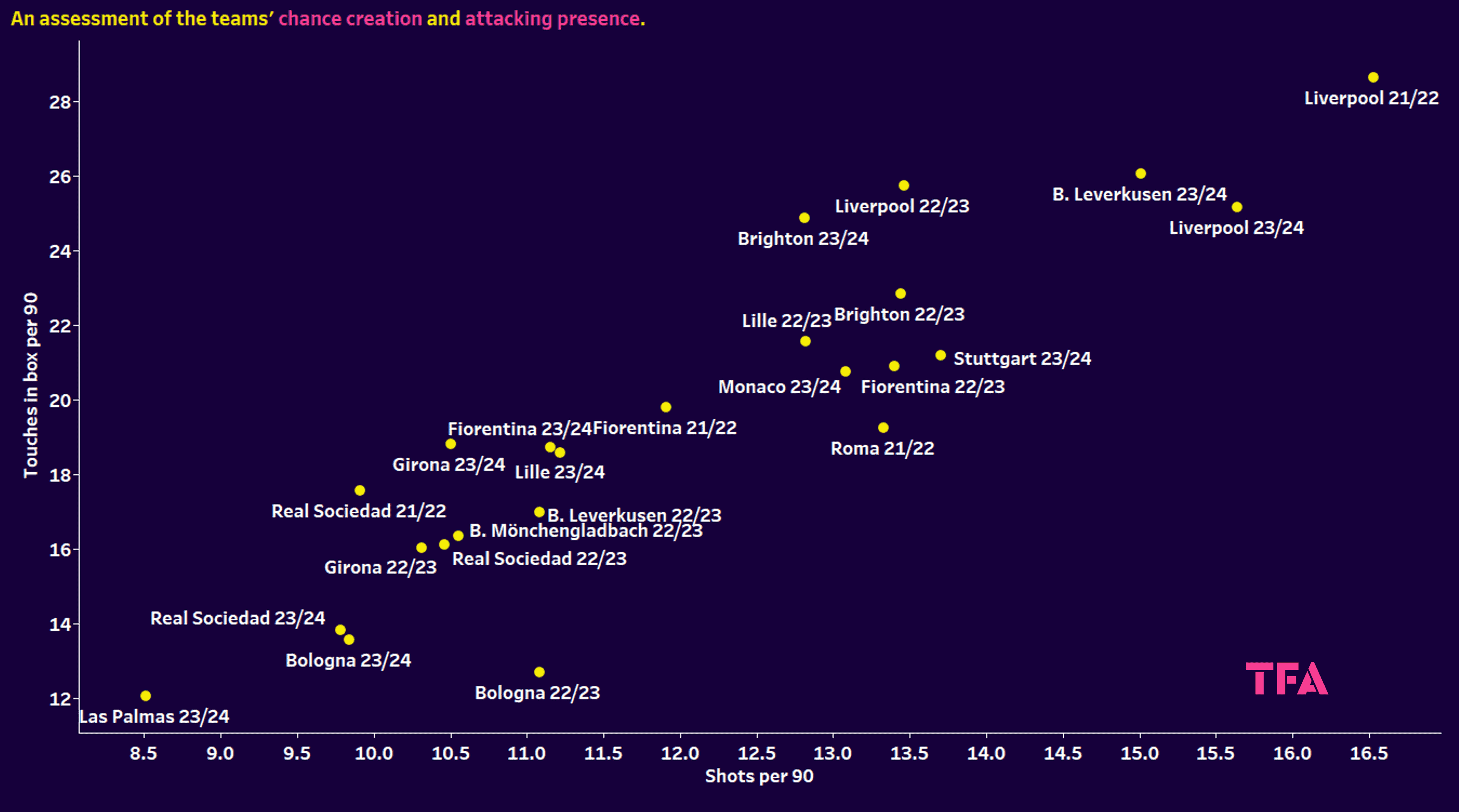
Digging deeper in the attacking tendencies of each coach, we can get a clearer idea of the attacking presence they offer. This graph shows us the frequencies for both shots per 90 and touches in the box per 90 for each club – high involvement in both of these indicates consistency in attacking presence.
No surprise *that* Liverpool team from 21/22 are out ahead of everyone by some distance in both metrics; their current side ranks high up as well in fairness. This is where we get more evidence of Alonso’s immense work at Leverkusen, with his side impressing in attack. This season, they average 15.01 shots per 90 – higher than Liverpool’s average last season and just below the Reds’ average- while completing 26.05 touches in the box per 90 – a sign of consistent successful build-up play.
De Zerbi’s Brighton side have demonstrated an impressive and eye-catching attacking presence over the last two campaigns, which is backed up by the numbers. The Italian’s attacking possession system is something to behold. We see Hoeneß’s Stuttgart and Italiano’s Fiorentina rank high again as well.
Conclusion: The top candidates
There we have it, we have the numbers. All of the managers involved in the analysis have clear talent and likely have exciting futures in the world of football management, but Liverpool can only hire one manager. Us, though – we can pick three top candidates…
Honourable mentions could include five or six here, based on the data we’ve seen. But we’d like to highlight Roberto De Zerbi and Imanol Algucail, who have created individual tactical philosophies that have resulted in clear progression for their sides. In terms of highlighting candidates for a Klopp replacement, they could easily have their names thrown into the hat, as could Zidane. No, he wasn’t involved in this data set due to being currently unemployed and also seemingly taking a different tactical direction to Klopp, but his calibre and trophy track record as a manager cannot be ignored. He has to be in the frame. But, on to the three names that we think should be considered based on the data we’ve presented.
Xabi Alonso
The former Liverpool midfielder has worked magic in the Bundesliga, transforming Leverkusen into genuine title contenders – his side are the only remaining unbeaten team in league competition in Europe’s top five leagues; seriously impressive stuff. Liverpool might want to strike while the iron’s hot – he is also likely to have a good impact on the current squad, and we already know of the existing strong link between him and the fans. His attacking style of play has proven to be hard to defend against, but if there is one thing that goes against Alonso, it’s the lack of experience in managing at the top level; but then again, the same could be said for our other two top candidates.
Sebastian Hoeneß
A coach that we included in our “24 for 24” magazine edition this month. The Stuttgart manager has his team operating at a fantastic level in attack and defence. His style offers something of a mid-ground in terms of their out-of-possession approach – they don’t reach the pressing numbers like Liverpool do, but at the same time, they are far from docile. A “big” move for Hoeneß cannot be far away, and while the Liverpool job may be just out of his grasp at this moment, he’ll be on the radar of Europe’s elite soon enough. So, how can we include him in our top three after saying that? Well, don’t rule it out, basically. From a strictly data perspective, he has his Stuttgart team firing on all cylinders, currently third in the Bundesliga.
Vincenzo Italiano
Another name that has gone somewhat unrecognised in the mainstream. Make no mistake, though: Vincenzo Italiano is a superb coach and has demonstrated his ability to get the best of the team at his disposal. As we mentioned, he’s taken Fiorentina out of life in mid-table and turned them into Champions League qualification contenders – in a short period of time, all things considered. He is highly aggressive off the ball – Liverpool fans would enjoy that; his side also shows attacking progression.






Comments